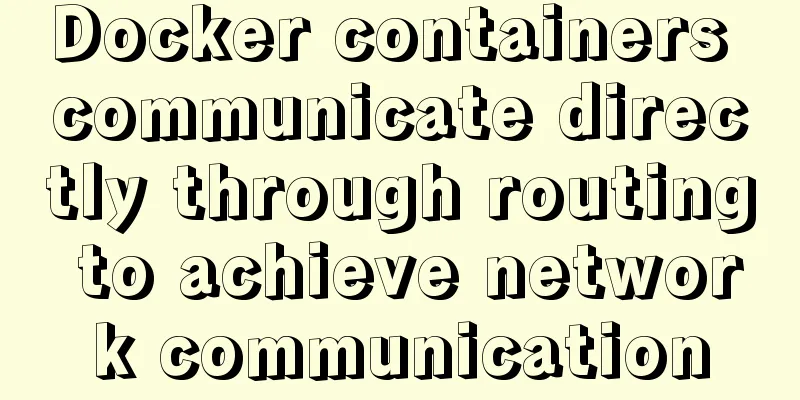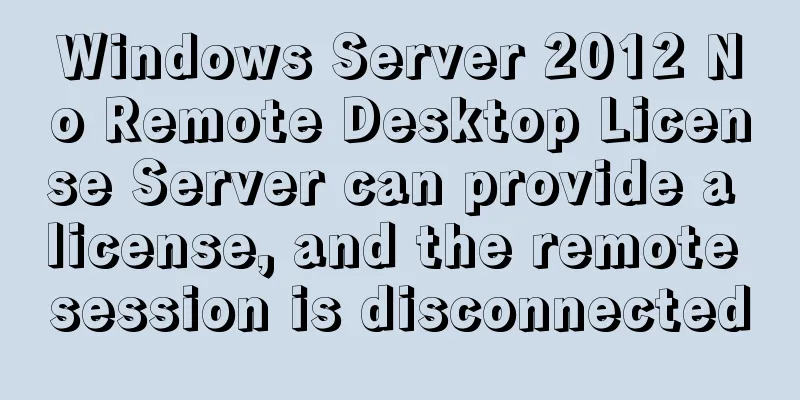Docker containers communicate directly through routing to achieve network communication

|
Overview As for the current default network of Docker itself, different Docker containers on a single host can communicate directly with the help of the docker0 bridge, which is fine. However, Docker containers on different hosts can only communicate by mapping ports on the host. Sometimes this method is inconvenient and may not even meet our requirements. Therefore, it is necessary for Docker containers on different physical machines to communicate directly using their own IP addresses. Furthermore, if we start Docker containers on different physical hosts, we will inevitably encounter cross-host communication problems of Docker containers. Let’s try it in this article.
How can the Docker containers on the two hosts communicate directly through IP addresses at this time? One solution that comes to mind is to enable direct communication between two centos containers by adding routes in their respective hosts. Analysis of the scheme principle Since the container's IP is used for routing, it is necessary to avoid containers on different hosts using the same IP. To this end, we should assign different subnets to different hosts to ensure this. So we construct a routing solution for communication between two containers, as shown in the following figure.
The configurations are as follows:
After this configuration, the Docker containers on the two hosts will definitely not use the same IP address, thus avoiding IP conflicts. Next, we define two routing rules:
To summarize, the data packet transmission process between two containers is as follows:
This is what we have in mind. Let's put it into practice to see if it is feasible. Actual test • 1. Configure docker0 on host 1 and host 2 respectively Edit the /etc/docker/daemon.json file on host 1 and add the following content: "bip": "ip/netmask"
{ "bip":"192.168.100.252/24" }Edit the /etc/docker/daemon.json file on host 2 and add the following content: "bip": "ip/netmask"
{ "bip":"192.168.200.252/24" }• 2. Restart the docker service Run the following command on both host 1 and host 2 to restart the docker service to make the modified docker0 network segment take effect systemctl restart docker • 3. Add routing rules Add routing rules on host 1 as follows: route add -net 192.168.200.0 netmask 255.255.255.0 gw 192.168.18.141 Add routing rules on host 2 as follows: route add -net 192.168.100.0 netmask 255.255.255.0 gw 192.168.18.162 • 4. Configure iptables rules Add the following rules on host 1: iptables -t nat -F POSTROUTING iptables -t nat -A POSTROUTING -s 192.168.100.0/24 ! -d 192.168.0.0/16 -j MASQUERADE Add the following rules on host 2: iptables -t nat -F POSTROUTING iptables -t nat -A POSTROUTING -s 192.168.200.0/24 ! -d 192.168.0.0/16 -j MASQUERADE • 5. Start the container Start the centos container on host 1: docker run -it --name container1 centos /bin/bash Start the centos container on host 2: docker run -it --name container2 centos /bin/bash • Install ifconfig on both machines and check the container's IP address using the command: [root@695ba390d221 /]# yum search ifconfig [root@695ba390d221 /]# yum install net-tools.x86_64 Container ip address on host 1:
Container ip on host 2:
• 6. Direct communication between containers OK, now the two containers can ping each other. Ping on host 1:
Ping on host 2:
Summarize The above is the full content of this article. I hope that the content of this article will have certain reference learning value for your study or work. Thank you for your support of 123WORDPRESS.COM. If you want to learn more about this, please check out the following links You may also be interested in:
|
<<: 5 ways to determine whether an object is an empty object in JS
>>: How to create a my.ini file in the MySQL 5.7.19 installation directory
Recommend
js and jquery to achieve tab status bar switching effect
Today we will make a simple case, using js and jq...
Node+express to achieve paging effect
This article shares the specific code of node+exp...
Implementation of building Kubernetes cluster with VirtualBox+Ubuntu16
Table of contents About Kubernetes Basic environm...
Detailed explanation of the difference between "/" and "~" in Linux
"/" is the root directory, and "~&...
Detailed graphic tutorial on downloading and installing VirtualBox software and installing and deploying it in Linux environment
1. Download and install VirtualBox software First...
Implementation code for using CSS text-emphasis to emphasize text
1. Introduction In the past, if you wanted to emp...
How to use http and WebSocket in CocosCreator
Table of contents 1. HttpGET 2. HTTP POST WebSock...
New usage of watch and watchEffect in Vue 3
Table of contents 1. New usage of watch 1.1. Watc...
JavaScript to achieve full screen page scrolling effect
After I finished reading JavaScript DOM, I had a ...
CentOS 7 set grub password and single user login example code
There are significant differences between centos7...
How to install and configure Docker nginx
Download Nginx image in Docker docker pull nginx ...
How to start source code debugging of tomcat in Idea and enter into tomcat for debugging
When using the idea development tool to debug cod...
CSS code to distinguish ie8/ie9/ie10/ie11 chrome firefox
Website compatibility debugging is really annoyin...
Analysis and solution of the problem that MySQL instance cannot be started
Table of contents Preface Scenario Analysis Summa...
How to create a responsive column chart using CSS Grid layout
I have been playing around with charts for a whil...















